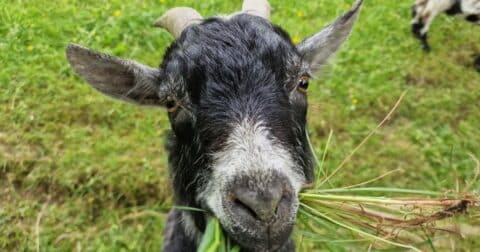News
Could Genetically Engineered Fungus Help Replace Animal Protein?
Breakthroughs•5 min read
Explainer
So many animals assist humans and the ecosystem. These are arguably some of the most helpful.


Words by Seth Millstein
It’s been said that no person is an island, and the same is true of species. Humans may be the dominant life forms on Earth, but we rely on many other animals to get by, and that’s been the case ever since we domesticated wolves at least 15,000 years ago. Earth is an extremely diverse planet, and many of its animals play a big role in helping humans — sometimes intentionally, sometimes by accident — and not always consensually.
We’ve found many ways to enlist the support of animals in our day-to-day lives. Sometimes, we train them to do what we want; other times, animals inadvertently help humans simply by living their natural lives.
One of the most basic ways in which animals help humans is by providing manual labor. That means pulling carts or carriages, carrying supplies, transporting humans or sometimes all three at once. Horses, oxen, donkeys and llamas are just a few examples of working animals.
It’s believed that early humans relied on wolves to alert them to danger; in exchange, they’d give the wolves scraps of carcasses, and this, according to many anthropologists, is how the dog was domesticated. Ever since then, we’ve used animals for protection; dogs remain the most well-known guardians, but they’re not the only ones. Donkeys, geese, llamas, snakes and even crocodiles have been used as guard animals in various capacities.
Many people with disabilities rely on a service animal to help them navigate the world. Guide dogs for the visually-impaired are the most obvious examples of this, but service animals can also be trained to fetch items for their owners, open doors and perform various simple household tasks. Some dogs are even trained to detect blood sugar levels in people with diabetes, and alert them when their levels spike or drop.
Emotional support animals are like service animals, but for psychological conditions rather than physical ones. They’re used to provide companionship to people with depression, anxiety, phobias and other ailments. Unlike service animals, they aren’t usually trained for any specific tasks; rather, it’s simply their presence and companionship that aids those who rely on them.
Although dogs are the most well-known emotional support animals, any legal pet can be registered as an emotional support animal in the United States.
Therapy animals are similar to emotional support animals in that they provide comfort and affection for humans in need. But while emotional support animals generally only serve a single person, therapy animals are brought by their human to certain places — usually hospitals or schools — and made available to anybody who wants their companionship.
Many animals are essential to maintaining Earth’s ecosystem, and some even play an important role in fighting climate change. They don’t know that they’re doing this, of course, but by simply going about their natural lives, these creatures are helping preserve the planet for future generations.
The concept of a “pest” isn’t so clear cut. Where we humans see a pest, another animal might see breakfast. Many creatures help humans out by gobbling up the critters that we don’t want around. It’s believed that this was one of the initial drivers of the human-cat relationship, with sailors bringing cats on to ships in order to clear them of mice; whether this counts as humans domesticating cats in order to get rid of mice — or cats domesticating humans in order to get access to mice — is still up for debate, however.
Of course, many animals enrich our lives by providing us with companionship, friendship and company. The importance of this shouldn’t be downplayed, as many studies have found that having a pet can make you live longer. Countless animals have played this role throughout history.
In addition to the examples listed above, a good number of animals have highly specific skills that help humans carry out various activities. From truffle-sniffing pigs to landmine-detecting rats, many animals can accomplish certain tasks much better than we can.
Man’s best friend deserves the top spot, due to the sheer number of ways that they’ve come to help humans. In addition to providing general affection and companionship, many dogs are also trained to:
Given that dogs co-evolved with humans, it’s not surprising that they’re able to help us in so many different ways.
Messenger pigeons may seem like the stuff of fables and cartoons, but they’re real, and they work. Pigeons have a sense called magnetoreception that allows them to perceive the Earth’s magnetic fields, and they can use this sense to navigate back to a designated “home” from hundreds of miles away. Messenger pigeons have been used extensively during wartime to transmit sensitive information, and have been credited with saving many lives in this way.
While the use of messenger pigeons has declined over time, they aren’t entirely obsolete. The Indian state of Odisha, which has relied on messenger pigeons for decades, still keeps a fleet of them trained and ready, just in case there’s a large-scale communications failure or power loss. More significantly, so does the Chinese military.
In addition to being a mode of transportation for many, elephants play several important ecological roles as well. They’re prolific dispersers of seeds; simply by eating plants, walking somewhere else and then defecating, elephants plant high carbon-density trees that are crucial to fighting climate change. They clear passageways in densely-forested regions, which allows other species to move more freely, and even their footprints can serve as micro-ecosystems for mayflies, tadpoles and other small species.
In addition, elephants have helped people survive natural disasters on several occasions. When Nepal was hit with flash floods in 2017, for instance, elephants saved hundreds of people from drowning by carrying them to safety.
People often use the word “leech” to refer to a person who’s a mooch, but actual leeches can save a person’s life. While it’s true that the earliest uses of leeches in medicine probably inflicted more harm than good, scientists have since found a way to use them in a way that actually benefits patients.
Certain surgeries can result in a complication called venous congestion, which causes blood to pool at the site of the surgery and prevents it from re-circulating. Leech saliva has several properties that rectify this and allow the blood to circulate, and doctors often use them for exactly this purpose.
Goats will eat almost anything, including tough, high-growing or woody plants that other herbivores ignore. They also have a voracious appetite, and these qualities make them perfect for clearing out brush and other invasive plants. It’s not uncommon for municipalities and landowners to rent goats and let them loose on brush-filled land, as they’re much cheaper and more environmentally-friendly than pesticides or lawnmowers.
Cats are often thought of as aloof and independent, but it’s worth remembering why we took a liking to them in the first place. In addition to the fact that they’re furry and cute, cats catch and eat rodents, which makes them an invaluable form of pest control. It’s believed that this is how domesticated cats were spread around the world, as they were taken on cargo ships to clear them of rats.
Nowadays, cats that perform this task are known as “mousers,” and they’ve performed this role in several official capacities. In 1943, a cat named Herman was so good at keeping the ports of Baltimore rodent-free that the US Coast Guard made him an official member; he was given the title “Expert Mouser” and issued an official ID card, complete with a serial number and pawprint. The British government has also employed several mousers over the decades, and created the official position of Chief Mouser to the Cabinet Office in 2011. The current officeholder is Larry.
While some people think of rats as pests, and most cats think of them as dinner, many war-torn countries have deployed rats to save lives. Rats can be trained to detect landmines, and they’ve been used for this purpose with amazing results around the world.
It works in part because of a rat’s keen sense of smell, and in part because they’re so light that they don’t set off the mines when they run over them. In 2020, a Cambodian mine-sniffing rat named Magawa was awarded a gold medal by the People’s Dispensary for Sick Animals after helping clear landmines from over 35 acres of land.
Whale feces contain nutrients that stimulate the growth of phytoplankton, which feeds many sea creatures and is at the base of several marine food chains. Phytoplankton also traps carbon dioxide, thus helping to reverse the effects of climate change, and releases oxygen into the air — a lot of it. Phytoplankton are responsible for half of the oxygen that we breathe.
Whales even help the environment from beyond the grave. When a whale dies, its carcass falls to the ocean floor and becomes a major food source for other sea creatures. This is called a “whale fall,” and its impact is immense: Whale carcasses effectively become their own ecosystems, and can continue feeding other organisms for decades after their initial death.
Much has been written about the special bond between humans and horses, which extends far beyond horseback riding. Horses are used therapeutically to help people dealing with many physical and emotional challenges, including PTSD, cerebral palsy, multiple sclerosis, anxiety, addiction and more. This practice is so common that there’s a term for it: Equine-assisted therapy, or EAT for short.
What makes horses so helpful in therapy? Part of it is due to the calming, de-stressing effect that they have on people, as studies have shown that even being in the presence of a horse can reduce a person’s heart rate. In addition, horses are highly reactive to human emotions and facial expressions, and this sensitivity makes them ideal for socializing children on the autism spectrum. Finally, riding a horse builds core strength and postural symmetry, and they’re often used in physical therapy for this reason.
Pollinators are animals that transport pollen from the male part of a plant to the female part, thus fertilizing it. Bees are the most famous and likely the most prolific of them, but plenty of other creatures pollinate as well, including certain wasps, birds, moths, bats and even lizards.
Human society would be dramatically different without these creatures. More than one-third of all crops on the planet require animal pollinators to reproduce, including such staples as potatoes, coffee, apples, almonds and chocolate. In addition, three-fourths of all flowers depend on pollinators for reproduction, so without the birds and the bees, our lives would be much less pretty, and much less delicious. Unfortunately, some of the world’s bees are under threat from certain pesticides, disease and climate change — and even, in some cases, other bees.
Truffles are considered a delicacy, but they’re difficult to farm because they grow underground and develop very slowly. Pigs, however, have a knack for smelling and locating them in the wild. It’s believed that this is because truffles contain a chemical, 5a-androst-16-en-3a-ol, that’s also synthesized in boar testicles and plays an important role in the animal’s mating process. As such, farmers use pigs to locate wild truffles, which they can smell from up to three feet underground.
It’s all too easy to see animals in the simplest of terms — whether that be a pet or a pest. But the more we learn about Earth’s creatures, especially the complex and conflicting details, the better we’ll understand our own impact on the planet.